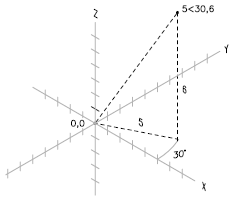3D cylindrical coordinates describe a precise location by a distance from the UCS origin in the XY plane, an angle from the X axis in the XY plane, and a Z value.
Cylindrical coordinate entry is the 3D equivalent of 2D polar coordinate entry. It specifies an additional coordinate on an axis that is perpendicular to the XY plane. Cylindrical coordinates define points by a distance in the XY plane from the UCS origin, an angle from the X axis in the XY plane, and a Z value. You specify a point using absolute cylindrical coordinates with the following syntax:
X<[angle from X axis],Z
In the illustration below, 5<30,6 indicates a point 5 units from the origin of the current UCS, 30 degrees from the X axis in the XY plane, and 6 units along the Z axis.

When you need to define a point based on a previous point rather than the UCS origin, you can enter relative cylindrical coordinate values with the @ prefix. For example, @4<45,5 specifies a point 4 units in the XY plane from the last point entered, at an angle of 45 degrees from the positive X direction, and extending 5 units in the positive Z direction.